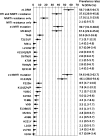Virological failure rates and HIV-1 drug resistance patterns in patients on first-line antiretroviral treatment in semirural and rural Gabon
- PMID: 23199801
- PMCID: PMC3510650
- DOI: 10.7448/IAS.15.2.17985
Virological failure rates and HIV-1 drug resistance patterns in patients on first-line antiretroviral treatment in semirural and rural Gabon
Abstract
Introduction: As antiretroviral treatment (ART) continues to expand in resource-limited countries, the emergence of HIV drug resistance mutations (DRMs) is challenging in these settings. In Gabon (central Africa), no study has yet reported the virological effectiveness of initial ART given through routine HIV care.
Methods: Following the World Health Organization (WHO) recommendations, a cross-sectional study with a one-time HIV-1 RNA viral load (VL) measurement was conducted in Gabon to assess virological failure (VF) defined by a VL result ≥1000 copies/ml and DRMs among adult patients living with non-B HIV-1 strains and receiving first-line non-nucleoside reverse transcriptase inhibitor (NNRTI)-based antiretroviral therapy for at least 12 months. Risk factors associated with VF and DRMs were assessed.
Results: Between March 2010 and March 2011, a total of 375 patients were consecutively enrolled from two decentralized (one semirural and one rural) HIV care centres. Median time on ART was 33.6 months (range, 12-107). Overall, the rate of VF was 41.3% (36.4-46.4). Among viremic patients, 56.7% (80/141) had at least one DRM and 37.6% had dual-class resistance to nucleoside reverse transcriptase inhibitors (NRTIs) and NNRTIs. The most frequent DRMs were K103N/S (46.1%) and M184V/I (37.6%). Thymidine analogue mutations were found in 10.6%. Independent risk factors associated with VF were being followed up at the semirural centre (P=0.033), having experienced unstructured treatment interruptions (P=0.0044), and having low CD4+ counts at enrolment (P<0.0001). A longer time on ART (P=0.0008) and being followed up at the rural centre (P=0.021) were risk factors for DRMs.
Conclusions: This is the first study conducted in Gabon providing VF rates and DRM patterns in adult patients receiving first-line ART. In sub-Saharan Africa, where NNRTI-based regimens are recommended as the standard for first-line ART, strengthening virological monitoring together with preventing unplanned treatment interruptions are a global public health priority.
Figures

References
-
- Bennett DE, Bertagnolio S, Sutherland D, Gilks CF. The World Health Organization's global strategy for prevention and assessment of HIV drug resistance. Antivir Ther. 2008;13(Suppl. 2):1–13. - PubMed
-
- Caron M, Makuwa M, Souquiere S, Descamps D, Brun Vezinet F, Kazanji M. Human immunodeficiency virus type 1 seroprevalence and antiretroviral drug resistance-associated mutations in miners in Gabon, central Africa. AIDS Res Hum Retroviruses. 2008;24:1225–8. - PubMed
Publication types
MeSH terms
Substances
LinkOut - more resources
Full Text Sources
Medical
Research Materials

